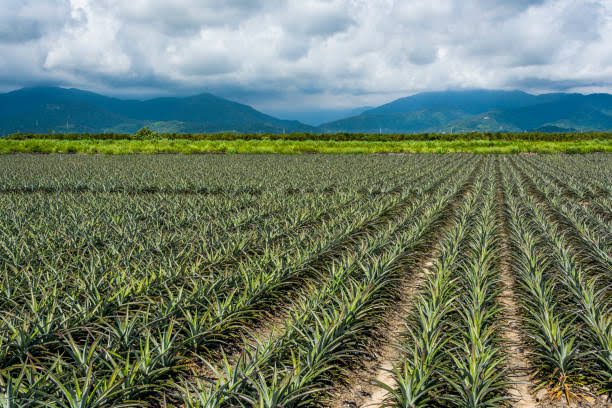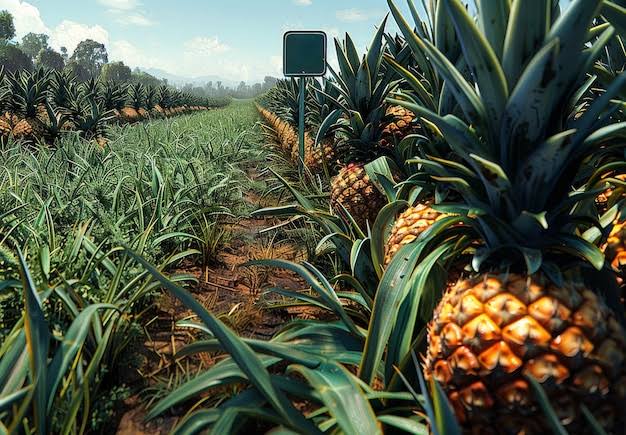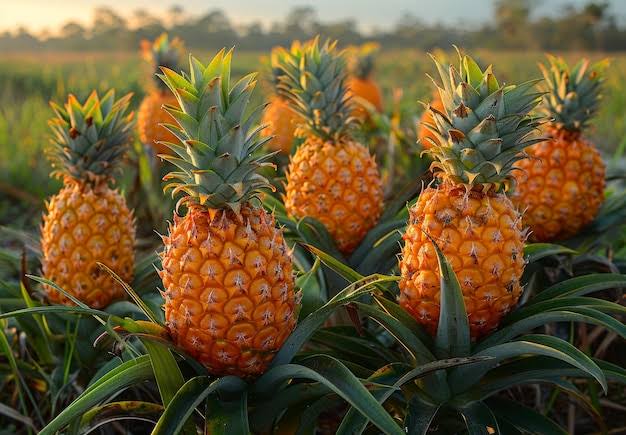Pineapple spacing is a critical factor that significantly influences the growth, yield, and overall health of pineapple plants. Properly determining the spacing for pineapple planting can enhance productivity and facilitate the management of pests and diseases.
When establishing a pineapple farm, it’s essential to consider the appropriate pineapple planting distance, which can vary based on the variety of pineapple and the specific growing conditions.
In terms of pineapple spacing in centimeters, the recommended distance typically ranges from 30 to 90 cm between plants, depending on the cultivation method and environmental factors.
Generally, a spacing of about 60 cm between individual pineapple plants is common for optimal growth. This distance allows for sufficient air circulation and sunlight penetration, which are crucial for healthy plant development. The planting distance of pineapple also plays a vital role in maximizing land usage.
A denser planting arrangement may increase the number of plants per hectare, but it can lead to competition for nutrients, water, and light. Therefore, careful consideration of the spacing of pineapple is essential for achieving a balance between plant density and resource availability.
Pineapple plant spacing can also impact irrigation and fertilization practices. Adequate spacing allows farmers to apply water and nutrients effectively without causing runoff or wastage. When plants are spaced too closely together, it becomes challenging to manage irrigation systems, particularly in regions with limited water resources.
This is where the selective use of herbicides becomes beneficial. By implementing a selective herbicide for pineapple cultivation, farmers can minimize weed competition while maintaining healthy pineapple plants.
Fertilization is another critical aspect of pineapple cultivation, and using the right type of fertilizer is essential for maximizing yield. Urea fertilizer for pineapple is often recommended due to its high nitrogen content, which promotes robust growth and development.
Applying urea at the appropriate time, ideally during the early stages of growth and then again at flowering, can significantly improve plant vigor and fruit size. Moreover, understanding the maturity period for pineapple is vital for planning the cultivation cycle.
Typically, the maturity period for pineapple ranges from 18 to 24 months, depending on the variety and growing conditions. By managing pineapple spacing effectively, farmers can optimize their crop’s growth rate and ensure timely harvesting.
When establishing a pineapple plantation, it’s important to consider the climate and soil conditions. Pineapples thrive in well-drained, sandy loam soils with a pH between 4.5 and 6.5. Conducting soil tests before planting can help determine the best amendments and ensure optimal growth conditions.
In addition to spacing considerations, farmers should also pay attention to pest and disease management. Pineapples are susceptible to various pests, including aphids, mealybugs, and fruit flies. By providing adequate spacing, farmers can reduce the likelihood of pest infestations and promote the effectiveness of integrated pest management strategies.
The arrangement of pineapple plants can also facilitate easy access for maintenance activities, such as weeding, fertilization, and harvesting. A well-planned layout not only improves accessibility but also enhances overall farm management.
Furthermore, pineapple spacing affects the post-harvest handling of the fruit. When harvested, pineapples must be handled carefully to avoid bruising and damage. Sufficient spacing during growth allows for better airflow around the fruit, reducing the risk of fungal infections during storage.
Proper pineapple planting spacing can also improve the overall aesthetic appeal of the plantation, which is especially important for farms that engage in agri-tourism. A well-maintained plantation with uniform plant spacing is visually appealing and can attract visitors who wish to learn more about pineapple cultivation.
Farmers should also consider their planting and harvesting schedules based on the maturity period for pineapple. By staggering planting dates and carefully managing spacing, farmers can ensure a continuous supply of fresh fruit throughout the year. This approach not only maximizes profits but also helps in maintaining consistent market presence.
Tips for Effective Pineapple Plant Spacing

Pineapple spacing is crucial for successful cultivation and maximizing yields. Proper spacing can significantly affect plant growth, fruit quality, and overall farm management. Here are some essential tips to consider for effective pineapple spacing that will help you achieve the best results in your pineapple farming endeavors.
1. Understand Optimal Spacing Requirements: The ideal pineapple spacing can vary depending on factors such as the variety of pineapple, soil fertility, and climate conditions. Generally, a spacing of about 60 to 90 cm between plants is recommended. This distance allows adequate airflow, sunlight, and nutrients to reach each plant, reducing competition.
2. Consider Planting Layout: Depending on the size of your farm and the growing system you choose, the layout of your planting rows is crucial. A staggered layout can help optimize space and ensure that plants receive enough light and nutrients. You may also opt for a triangular arrangement instead of a traditional square layout, which can further improve spacing efficiency.
3. Conduct Soil Testing: Before planting, conduct soil tests to determine nutrient levels and pH. The soil’s condition will influence your choice of spacing and the amount of fertilizer you may need to apply.
Well-drained, sandy loam soils with a pH of 4.5 to 6.5 are ideal for pineapple cultivation. Knowing your soil’s properties can help you make informed decisions about spacing.
4. Implement Crop Rotation: Crop rotation can enhance soil health and fertility, impacting your pineapple spacing strategy. By alternating crops, you can minimize soil nutrient depletion and reduce the risk of pests and diseases. After growing pineapples, consider planting legumes or other cover crops that improve soil quality, allowing you to maintain effective spacing when replanting.
5. Utilize Raised Beds: Using raised beds for pineapple cultivation can improve drainage and aeration. When employing this method, maintain appropriate pineapple spacing to allow plants enough room to grow. Raised beds can help mitigate issues related to overwatering and soil compaction, which can affect root development.
6. Employ Proper Fertilization Techniques: Fertilization plays a crucial role in the growth of pineapple plants. When determining your pineapple spacing, factor in how you will apply fertilizers, particularly urea. Ensure that each plant receives adequate nutrients without overcrowding, which can lead to competition for resources.
7. Monitor Plant Health: Regularly inspect your pineapple plants for signs of disease or nutrient deficiencies. The distance between plants can help with disease management; closer plants may promote the rapid spread of pathogens. By maintaining proper pineapple spacing, you can reduce the likelihood of widespread issues, allowing for easier identification and treatment of problems.
8. Practice Integrated Pest Management (IPM): Pineapple spacing is also crucial for pest management. Implementing an IPM strategy helps control pests while minimizing the use of chemicals.
Proper spacing allows for easier access to plants, making it simpler to monitor and treat infestations. Additionally, the right spacing can help create a barrier against pest movement.
9. Ensure Adequate Irrigation: Efficient irrigation practices are essential for pineapple cultivation. Pineapples require consistent moisture, especially during the early growth stages. When establishing pineapple spacing, ensure that your irrigation system can adequately reach each plant without causing waterlogging or uneven distribution of water.
10. Stagger Planting Dates: To maximize harvests, stagger your planting dates. This approach allows you to extend the harvesting period and manage spacing effectively. By planting at different intervals, you can create a continuous supply of pineapples and optimize space utilization on your farm.
11. Prune and Manage Weeds: Regular pruning and weeding can enhance the effectiveness of your pineapple spacing. Keep the area around your plants free of weeds, which compete for nutrients and water. Pruning any excess foliage helps ensure that sunlight reaches all plants, promoting even growth and maximizing yield.
12. Understand Maturity Period: Knowing the maturity period for pineapple is essential in planning your planting and spacing. Pineapples typically take 18 to 24 months to mature, depending on the variety and growing conditions. Effective spacing allows you to manage and time your harvests more efficiently.
13. Use Protective Measures: Protect your pineapple plants from environmental stressors by utilizing protective covers or shade cloth if necessary. Proper spacing ensures that each plant has enough room to grow without interference from covers or structures.
14. Educate Yourself: Stay informed about the latest best practices in pineapple cultivation. Workshops, online resources, and agricultural extension services can provide valuable insights into effective pineapple spacing and overall farm management strategies.
15. Seek Expert Advice: If you’re new to pineapple farming or want to optimize your spacing techniques further, don’t hesitate to consult agricultural experts or experienced farmers. Their knowledge can help you make informed decisions regarding spacing, irrigation, and fertilization, leading to better overall results.
Read Also: Benefits of Independent Leaf
Balancing Pineapple Spacing and Fertilization for Optimal Growth

To cultivate healthy and productive pineapple plants, it is essential to strike a balance between pineapple spacing and fertilization. Proper spacing ensures that each plant receives adequate sunlight, air circulation, and nutrients, while effective fertilization provides the necessary elements for robust growth.
1. Understanding Pineapple Spacing
Pineapple spacing refers to the distance between individual pineapple plants when they are planted. The ideal spacing varies depending on factors such as plant variety, soil type, and farming methods.
Generally, a spacing of 60 to 90 centimeters (about 24 to 36 inches) between plants is recommended. This distance allows for adequate root development, air circulation, and sunlight penetration, all of which are critical for healthy plant growth.
When determining the best pineapple spacing for your farm, consider the following factors:
a. Plant Variety: Different pineapple varieties have varying growth habits and sizes. Larger varieties may require more space to thrive, while smaller ones can be planted closer together. Researching the specific needs of your chosen variety will help you establish appropriate spacing.
b. Soil Fertility: Fertile soils can support more robust plant growth, allowing for closer spacing. In contrast, poor or depleted soils may necessitate wider spacing to reduce competition for nutrients and water. Conducting soil tests can provide insights into the fertility levels of your land, enabling informed spacing decisions.
c. Climate and Environment: Climate conditions, such as humidity and temperature, play a role in plant health. In hotter climates, wider spacing may help reduce heat stress, while cooler regions might allow for closer planting. Adapt your spacing strategy based on local climatic conditions to promote optimal growth.
2. The Role of Fertilization
Fertilization is critical in pineapple cultivation, providing essential nutrients that support healthy growth and development. Pineapples require a balanced supply of macronutrients—nitrogen, phosphorus, and potassium—as well as micronutrients like magnesium, calcium, and sulfur. The right balance of fertilizers can enhance fruit quality and increase yields.
a. Nitrogen: This nutrient is vital for vegetative growth and leaf development. Adequate nitrogen levels promote strong, healthy foliage, which is essential for photosynthesis and energy production. Over-fertilization can lead to excessive leaf growth at the expense of fruit production, so maintaining the right balance is key.
b. Phosphorus: Phosphorus is crucial for root development and flowering. It enhances the establishment of a strong root system, enabling plants to absorb nutrients and water more effectively. Fertilizers rich in phosphorus are particularly beneficial during the early growth stages and when the plants begin to flower.
c. Potassium: Potassium contributes to overall plant health, improving resistance to diseases and stress factors. It plays a significant role in fruit development and quality. A well-balanced supply of potassium can result in sweeter, juicier pineapples, making it essential for successful cultivation.
3. Balancing Spacing and Fertilization
Achieving a harmonious balance between pineapple spacing and fertilization is critical for optimal growth. Here are several strategies to consider:
a. Soil Preparation: Before planting, prepare the soil to enhance its nutrient content. Incorporating organic matter, such as compost or well-rotted manure, can improve soil structure and fertility. This preparation will help support closer spacing while ensuring that nutrients are readily available for the plants.
b. Proper Planting Techniques: When planting pineapples, ensure that each plant is positioned correctly within its designated space. Avoid overcrowding, as this can lead to competition for light, water, and nutrients. Maintaining consistent spacing between plants will promote healthy growth and minimize the risk of disease.
c. Fertilizer Application Timing: The timing of fertilizer application is crucial for pineapple growth. It is essential to align fertilization with the growth stages of the plants. For instance, applying nitrogen-rich fertilizers during the vegetative stage supports leaf development, while phosphorus and potassium should be emphasized as the plants prepare for flowering and fruiting.
d. Monitor Plant Health: Regularly assess the health of your pineapple plants to determine if they require additional nutrients or adjustments in spacing. Signs of nutrient deficiency, such as yellowing leaves or stunted growth, may indicate the need for more targeted fertilization. Likewise, overcrowded plants may need to be thinned to ensure each one has adequate access to resources.
e. Use of Mulch: Mulching around pineapple plants can help retain soil moisture, suppress weeds, and improve soil fertility over time. Organic mulches, such as straw or wood chips, can break down and contribute nutrients to the soil, enhancing the effectiveness of your fertilization efforts while maintaining appropriate spacing.
f. Water Management: Watering practices also play a significant role in the balance of pineapple spacing and fertilization. Pineapples thrive in well-drained soils, and excessive water can lead to root rot.
Ensure that your watering practices complement the spacing and fertilization strategies you have implemented, providing plants with consistent moisture without over-saturating the soil.
g. Fertilizer Types: Choosing the right type of fertilizer can significantly impact how well your pineapple plants respond to spacing and fertilization strategies. Slow-release fertilizers can provide a steady supply of nutrients over time, minimizing the risk of nutrient leaching and allowing plants to absorb them effectively.
h. Adapt to Plant Growth: As pineapple plants grow, their nutrient requirements will change. Regularly evaluate your fertilization plan and adjust it based on the observed growth patterns and spacing of the plants. Flexibility in your approach will help ensure that the plants receive the right nutrients at the right times.
Read Also: Amazing Health Benefits of Uziza Leaf
Frequently Asked Questions on How to Achieve Ideal Pineapple Spacing for Healthy Growth

1. What is the ideal pineapple spacing?
The ideal pineapple spacing typically ranges from 60 to 90 centimeters (24 to 36 inches) between each plant. This spacing allows for adequate sunlight, air circulation, and nutrient uptake, promoting healthy growth. However, the specific spacing may vary based on factors such as soil fertility, plant variety, and local climate conditions.
2. How does pineapple spacing affect plant growth?
Proper pineapple spacing directly impacts plant health. Adequate space between plants allows for better air circulation, reducing the risk of fungal diseases and pests.
It also ensures that each plant receives sufficient sunlight, which is essential for photosynthesis and overall growth. Overcrowding can lead to competition for nutrients and water, stunting growth and reducing fruit quality.
3. Can I plant pineapples closer together if I use fertilizers?
While using fertilizers can enhance growth, planting pineapples too close together is not recommended. Even with fertilizer support, overcrowded plants may still compete for resources, leading to diminished yields and poor-quality fruit. Maintaining appropriate spacing is critical for the health and productivity of each pineapple plant, regardless of fertilization practices.
4. How can I determine the right spacing for different pineapple varieties?
Different pineapple varieties have unique growth habits and size requirements. Researching the specific needs of your chosen variety will help determine the ideal spacing.
Generally, larger varieties may require more space, while smaller or dwarf varieties can be planted closer together. Consulting local agricultural extensions or pineapple farming guides can also provide tailored recommendations.
5. What are the signs of overcrowding in pineapple plants?
Signs of overcrowding in pineapple plants include stunted growth, yellowing leaves, and reduced fruit size and quality. If you notice these symptoms, it may be necessary to thin out your plants to ensure each one has adequate access to light, water, and nutrients. Regular monitoring will help you identify overcrowding issues early, allowing for timely interventions.
6. How does soil fertility influence pineapple spacing?
Soil fertility plays a crucial role in determining the appropriate spacing for pineapple plants. In fertile soils, plants can thrive closer together, as there are ample nutrients available.
Conversely, in less fertile soils, wider spacing may be necessary to reduce competition and ensure that each plant can access enough nutrients. Conducting soil tests can provide valuable insights into soil fertility and guide your spacing decisions.
Read Also: Foods and Drinks That Can Cause Dehydration
Do you have any questions, suggestions, or contributions? If so, please feel free to use the comment box below to share your thoughts. We also encourage you to kindly share this information with others who might benefit from it. Since we can’t reach everyone at once, we truly appreciate your help in spreading the word. Thank you so much for your support and for sharing!

